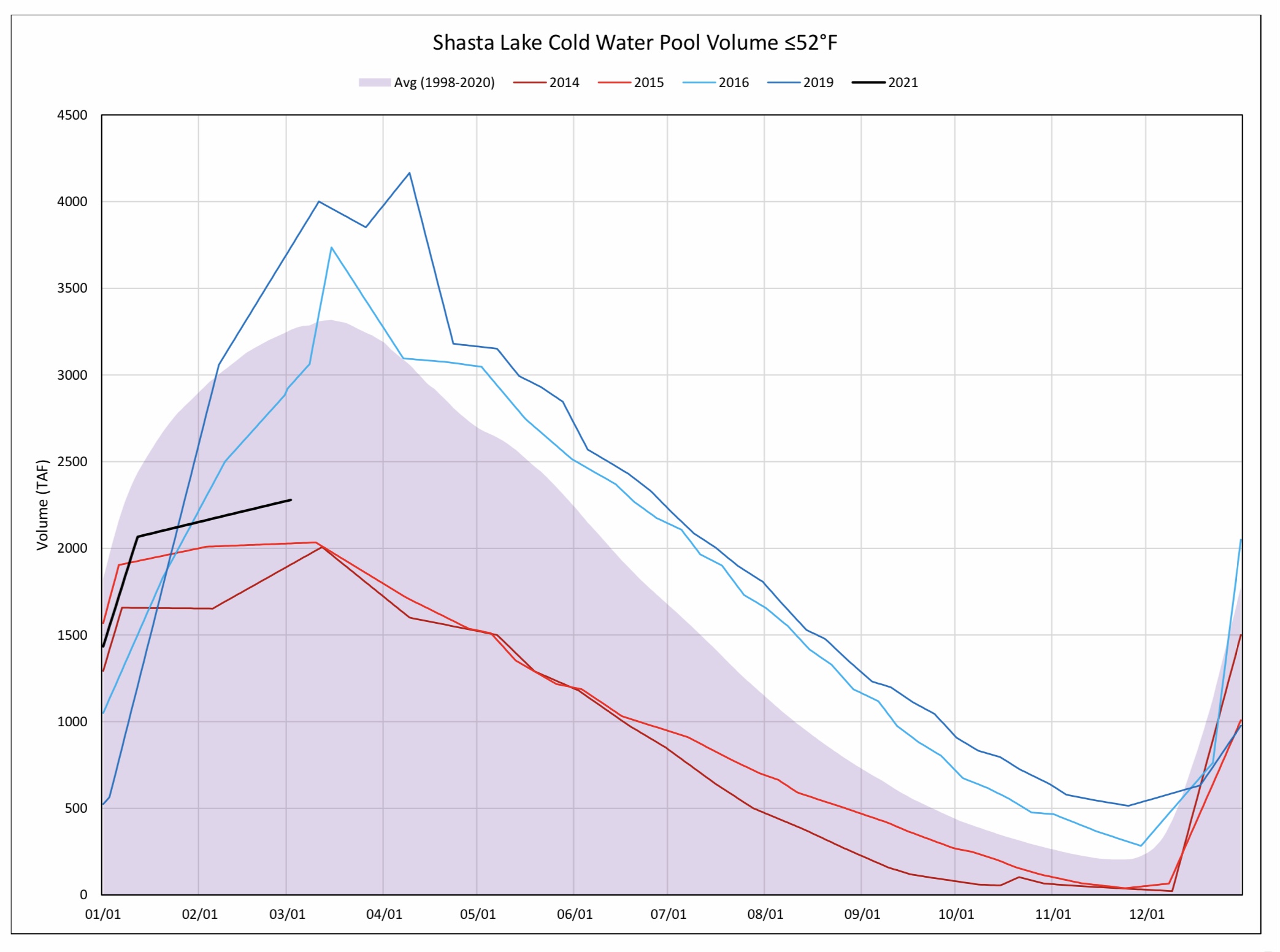Following an introductory post, this is the third post in a series on the lessons learned by the National Marine Fisheries Service (NMFS) from the 2013-2015 drought that devastated Sacramento River salmon populations. This post addresses Lesson #2.
 In 2014 and nearly again in 2015, Reclamation ran out of cold water in Lake Shasta available for release to maintain downstream salmon in late summer and early fall (Figure 1). Cutting late spring and early summer water deliveries to contractors from reservoir releases in most cases would preserve cold-water pool through to fall. In critical drought years 2014 and 2015, cold-water-pool volume on June 1 was about 1.2 million acre-ft. In wetter 2016 and 2019 cold-water-pool volume on June 1 was more than double that.
In 2014 and nearly again in 2015, Reclamation ran out of cold water in Lake Shasta available for release to maintain downstream salmon in late summer and early fall (Figure 1). Cutting late spring and early summer water deliveries to contractors from reservoir releases in most cases would preserve cold-water pool through to fall. In critical drought years 2014 and 2015, cold-water-pool volume on June 1 was about 1.2 million acre-ft. In wetter 2016 and 2019 cold-water-pool volume on June 1 was more than double that.
In late summer 2014, the available cold-water-pool ran out. Lower gates of the reservoir outlet tower began taking warmer surface water (Figures 2 and 3). Even the lowest “river outlets” water was over 60oF by early October. Water releases in June and July 2014 were near 10,000 cfs (Figure 4). That level of release was already being capped from the wet year level of 15,000 cfs. Dropping to 8,000 cfs could have saved another 4,000 acre-ft per day, or about 240,000 acre-ft, which may have sustained cold water releases through early October.
In June-July 2015, releases were dropped to near 7,000 cfs (Figure 4), but even then, water temperature in release water had to be compromised (Figure 5) to sustain some cold water into the fall (Figure 6). Subsequently, research indicated that the 2015 water temperature limit of 56oF for release water proved insufficient, and that a 53oF limit was necessary to protect eggs and embryo of salmon. Water temperatures were sustained near or below 53oF from 2016 to 2020 (Figure 6) by limiting June-July releases (see Figure 4).
In summary, capping releases in June-July, in combination with selectively drawing release water from reservoir water layers, was the normal procedure in preserving cold-water-pool release capability through the summer. However, despite highly restricted releases in critical drought years 2014 and 2015, the cold water ran out and salmon reproduction severely suffered. The lessons learned were that Reclamation’s temperature target for release water was too high, and that Reclamation’s predictive ability for preserving cold-water releases through the summer was ineffective and could not be trusted.

Figure 1. Cold-water pool volume in Shasta Reservoir in 2014, 2015, 2016, 2019, and 2021 with 1998-2020 average. Source: https://www.usbr.gov/mp/cvo/.

Figure 2. Water temperature profile in Shasta Reservoir and outlet tower Temperature Control Device configuration in August 2014.

Figure 3. Water temperature profile in Shasta Reservoir and outlet tower Temperature Control Device configuration in October 2014.

Figure 4. Shasta/Keswick reservoir water release rate in June-July 2012-2020.

Figure 5. Water temperature profile in Shasta Reservoir and outlet tower Temperature Control Device configuration in August 2015. Note some water was being released from middle gates to preserve cold water pool supply.

Figure 6. Water temperature below Keswick Dam Aug-Nov 2014-2020. Note higher water temperatures in 2014 and 2015.
